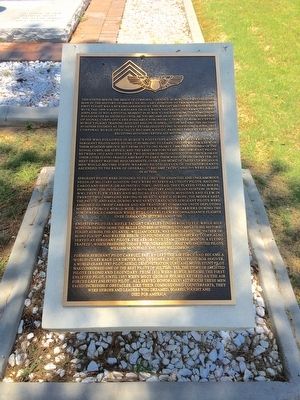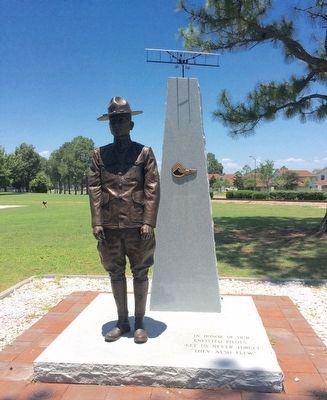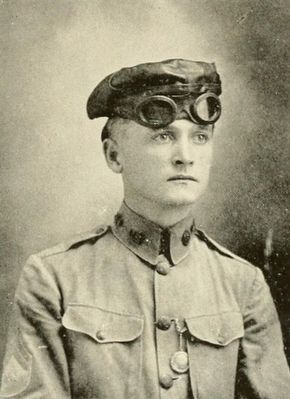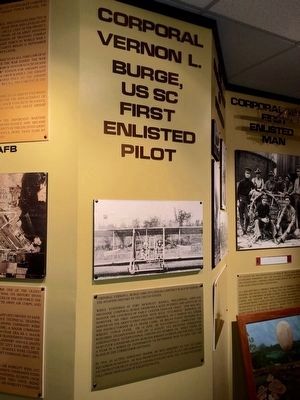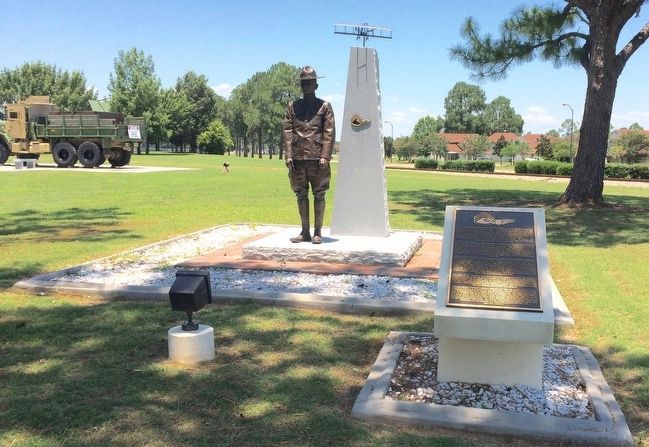Maxwell Air Force Base Gunter Annex in Montgomery County, Alabama — The American South (East South Central)
Corporal Vernon L. Burge
First Enlisted Pilot
Inscription.
This statue holds the image of Corporal Vernon L. Burge, the first enlisted man in the history of American military aviation to train as a pilot. His first flight was a reward arranged by the Wright Brothers for assisting with the 1909 Wright airplane trials when they sold the Army its first airplane. It was a pivotal moment in Burge’s life and from that time on he would never be satisfied until he too became an aviator. Due to a shortage of Signal Corps officers available for instruction, Lt. Lahm accepted Burge's flight training request and on 29 April, 1912 he became the second aviation student at the newly established flying school on 14 June 1912. Corporal Burge officially became a pilot, passing the FAI test and receiving aviation certificate No. 154.
Those who followed in Burge’s footsteps and were referred to as Sergeant Pilots have found it humbling to learn that few ever knew of their aviation service. But from 1912 to 1942 nearly 3,000 enlisted men of the Signal Corps, Air Service, and the Army Air Forces became Sergeant Pilots. Between 1912 and 1939 over two hundred motivated young men risked their lives flying fragile aircraft to earn their wings. In 1942 however, to meet urgent wartime requirements, over 2,500 more of these courageous men would become stripe-wearing pilots. Eleven of these sergeants ascended to the rank of general, 17 became “Aces”, and 155 were killed in action.
Sergeant Pilots were intended to fill only the essential and unglamorous needs of military aviation. They were to serve as utility pilots, hauling cargo and people, or as instructors. Instead, they played vital roles, pioneering the development of both military and civilian aviation. During WWI they flew ferry and medical evacuation missions and flew in twenty-two campaigns serving in Mexico, Africa, Europe, the Middle East, the Pacific and Asia. During WWII newly graduated Sergeant Pilots were assigned to troop carrier and Air Transport Command units deploying military forces world-wide. Some flew P-40s from carriers during the North Africa campaign while still other flew reconnaissance flights over Germany in Spitfires and P-38s.
Enlisted pilot Ira Biffle taught Charles Lindbergh to fly, while Bill Winston helped hone the sklls Lindbergh needed to complete his historic flight across the Atlantic. William Ocker, was considered the “Father of Blind Flight” and Walter Beech Co-founder of Beech Aircraft Corp, also served as Sergeant Pilots. The aerobatics team “Three Men on a Flying Trapeze”, which predated today’s “Thunderbirds”, had two enlisted pilots William McDonald and John Williamson.
Former Sergeant Pilot Carroll Shelby left the Air Force and became a world-class
race car driver and designer. Enlisted pilot Bob Hoover, a world class test pilot, aerial demonstration guru and movie stunt pilot was considered one of the best pilots of his time. Yes, the story of enlisted pilots is long and legendary. From 1912 when Burge became the first enlisted pilot, until 1957 when MSgt George Holmes retired as the Air Forces last enlisted pilot...all served honorably! Although these men faced incredible obstacles, like their commissioned counterparts, they were heroes and leaders who dreamed, soared, fought and died for America.
Topics. This historical marker is listed in these topic lists: Air & Space • War, World II. A significant historical date for this entry is April 29, 1912.
Location. 32° 24.272′ N, 86° 14.964′ W. Marker is in Maxwell Air Force Base Gunter Annex, Alabama, in Montgomery County. Marker can be reached from the intersection of McDonald Street and Avenue D. Located at the Enlisted Heritage Hall on Gunter Annex and requires base access. Touch for map. Marker is at or near this postal address: 550 McDonald St, Montgomery AL 36114, United States of America. Touch for directions.
Other nearby markers. At least 8 other markers are within walking distance of this marker. Khobar Towers (a few steps from this marker); Combat Skyspot (a few steps from this marker); Award of Air Force Cross to Jon D. Harston (a few steps from this marker); Award of Air Force Cross to John A. Chapman (a few steps from this marker); Award of Air Force Cross to Charles L. Schaub (within shouting distance of this marker); Award of Air Force Cross to Zachary J. Rhyner (within shouting distance of this marker); Award of Air Force Cross to Theodore M. Hamlin (within shouting distance of this marker); Award of Air Force Cross to Daniel P. Keller (within shouting distance of this marker). Touch for a list and map of all markers in Maxwell Air Force Base Gunter Annex.
Also see . . . Wikipedia article on the Vernon L. Burge. (Submitted on June 29, 2016, by Mark Hilton of Montgomery, Alabama.)
Credits. This page was last revised on July 16, 2023. It was originally submitted on June 29, 2016, by Mark Hilton of Montgomery, Alabama. This page has been viewed 500 times since then and 41 times this year. Photos: 1, 2, 3, 4, 5. submitted on June 29, 2016, by Mark Hilton of Montgomery, Alabama.
